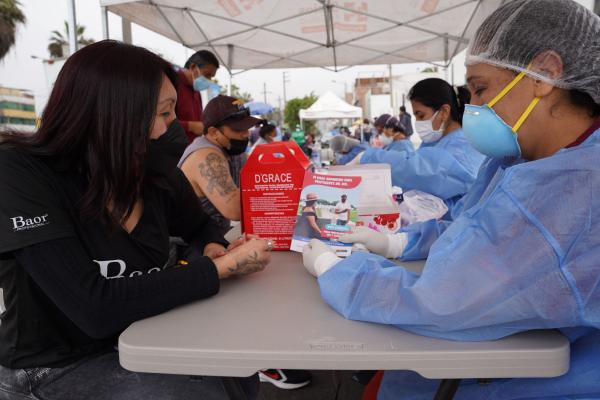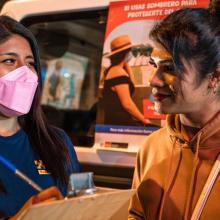In 2022, more than 600,000 people lost their lives due to HIV-related conditions, while 1.3 million contracted the infection globally. According to the World Health Organization (WHO), approximately 14% of people living with HIV are unaware of their health status.
Since its origin in the 1980s, AIDS has represented one of the greatest challenges to global public health, claiming the lives of more than 40 million people. In this regard, UNAIDS points out that stigma and discrimination are crucial obstacles in the task of eliminating the advance of the virus, partly due to misinformation and the persistence of myths that generate unjustified fears.
The human immunodeficiency virus (HIV) attacks the immune system by destroying certain white blood cells essential to our bodies, making affected individuals vulnerable to infection and disease. Its most advanced stage, if proper antiretroviral treatment is not followed, is known as acquired immunodeficiency syndrome (AIDS), which can take from 2 to 15 years to manifest if not treated in time.
The lack of knowledge and awareness poses problems such as limited access to available treatments due to the perception of the virus as a deadly and incurable disease; it also makes it difficult to take adequate preventive measures to stop transmission of the virus.
Thus, in commemoration of World AIDS Day (December 1), we seek to debunk some persistent myths surrounding this condition and continue to promote the importance of prevention and treatment for people affected by HIV/AIDS.
Myths surrounding HIV/AIDS
Stigma and discrimination against people living with HIV still persist in Peru. Approximately 51% of Peruvians with HIV have experienced cases of discrimination due to their condition, according to data from the Index of stigma and discrimination in people with HIV 2.0. These people face social prejudice, fear rejection and are subject to stigmatization.
This situation hinders access to information, early detection and proper medical care, so it is essential to debunk some popular myths:
1. If I live with HIV I cannot have a partner unless I also have HIV
Thanks to scientific advances, a person with HIV who rigorously follows his antiretroviral treatment can become untransmissible. This implies that his or her viral load is undetectable in blood and cannot transmit HIV. When within a relationship one person is living with HIV and the other is not, this couple is called serodiscordant.
2. Taking PrEP eliminates the need for a condom
PrEP (pre-exposure prophylaxis) consists of medications that decrease the chances of contracting HIV during sex. Although they are highly effective in preventing HIV infection, it is critical to note that they do not offer protection against other sexually transmitted infections (STIs) such as chlamydia, gonorrhea or syphilis. For this reason, it is essential to combine the use of PrEP with safe sex practices, which includes the use of condoms.
3. Vertical transmission: Is there a risk of HIV transmission to the baby?
Although mother-to-child transmission is possible during pregnancy, advances in medical treatment have provided the opportunity for people with HIV to conceive children free of infection. This situation is viable as long as they rigorously follow antiretroviral treatment, achieving undetectable levels of the virus, which reduces the risk of transmitting it to their children. In these circumstances, pregnancy planning becomes a crucial aspect to ensure the health and well-being of the future baby.
4. If I have had a risky exposure I can no longer prevent HIV
If you think you have been exposed to HIV, there are still preventive measures, such as post-exposure prophylaxis (PEP). PEP is an antiretroviral treatment that taken for 28 days can decrease the chances of contracting HIV if started up to 72 hours after a high-risk exposure. It should only be used in emergency situations.
5. HIV and AIDS are not the same
As mentioned earlier, HIV and AIDS are related, but they are not the same. HIV affects the body’s immune system, on the other hand, AIDS represents the most advanced stage of HIV, in which the body’s defenses are considerably weakened, leaving the person vulnerable to various life-threatening illnesses.
HIV/AIDS Prevention, Diagnosis and Treatment

Alexia nunca se había realizado una prueba de VIH hasta diciembre de 2022, cuando se encontró con una campaña de salud de JunTrans de Socios En Salud. Desde entonces, gracias al respaldo que ha recibido, se mantiene estable mediante su tratamiento antirretroviral.
Socios En Salud, through its HIV and STI Program, focuses on reinforcing comprehensive care, covering clinical, psychological and social aspects for the identification and care of sexually transmitted infections, from initial detection to the initiation and follow-up of treatment. Part of our activities are focused on actively searching in the community for people belonging to key groups (such as men who have sex with men, transgender women, sex workers), migrants and adolescents living with HIV.
During 2022, several milestones were achieved:
- More than 8,336 people accessed HIV testing, of which 31% (2,757) underwent first-time screening.
- Through mobile health brigades in North Lima, mainly targeting men who have sex with men, and in Metropolitan Lima focusing on transgender women, 60% of 140 people were referred to Sexually Transmitted Infections and HIV/AIDS Referral Centers (CERITSS) to begin antiretroviral treatment.
- The “Closing Gaps” project, financed by the Global Fund and implemented by Socios En Salud in coordination with MINSA and CONAMUSA, established 13 antiretroviral treatment (ART) centers in ten regions of the country in order to strengthen first-level care service, provide counseling and mitigate the effects of COVID-19 on people living with HIV.
From Socios En Salud we reaffirm our commitment to continue working to detect, support and provide treatment to people affected by HIV/AIDS. Through free screening tests, access to treatment and psychosocial support in search of decreasing stigmatization and improving the quality of life of those facing this disease.
.



